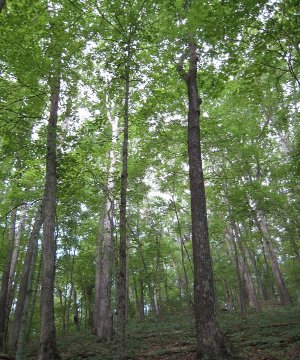Loamy Limestone/Dolomite Protected Backslope Forest
Scenario model
Current ecosystem state
Select a state
Management practices/drivers
Select a transition or restoration pathway
- Transition T1A More details
- Transition T1B More details
- Transition T1C More details
- Transition T1D More details
- Transition T2A More details
- Transition T3A More details
- Transition T4A More details
- Transition T5A More details
-
No transition or restoration pathway between the selected states has been described
Target ecosystem state
Select a state
Description
The reference state was dominated by white oak associated with northern red oak and other mixed hardwoods. Maximum tree age was likely 150 to 300 years. Periodic disturbances from fire, wind or ice maintained the dominance of white oak by opening up the canopy and allowing more light for white oak reproduction. Long disturbance-free periods allowed an increase in more shade tolerant species such as northern red oak and sugar maple. Two community phases are recognized in this state, with shifts between phases based on disturbance frequency.
The reference state can be found in scattered locations throughout the MLRA. Some sites have been converted to grassland (State 4). Others have been subject to repeated, high-graded timber harvests coupled with uncontrolled domestic livestock grazing (State 5). Fire suppression throughout the region has resulted in increased canopy density, which has affected the abundance and diversity of ground flora. Many reference sites have been effectively managed for timber harvesting, resulting in either even-age (State 2) or uneven-age (State 3) managed forests depending upon the removal intensity and the species selection.
Submodel
Description
This forest tends to be rather dense with an even-aged overstory and an under developed understory and ground flora. Thinning can increase overall tree vigor and improve understory diversity. Continual managed timber harvesting, depending on the practices used and age classes removed, will either maintain this state, or convert the site to uneven-age (State 3) forests.
Submodel
Description
An uneven-age managed forest can resemble the reference state. The primary difference is tree age, most being only 50 to 90 years old. Composition is also likely altered from the reference state depending on tree selection during harvests and disturbance activities. Without a regular 15 to 20 year harvest re-entry into these stands, they will slowly increase in more shade tolerant species such as sugar maple and white oak will become less dominant.
Submodel
Description
Conversion of forests to planted, non-native cool season grasses and legumes has been common. Without proper grassland management these ecological sites are challenging to maintain in a healthy, productive state. With over grazing and cessation of active pasture management, tall fescue, white clover and multi-flora rose will increase in density.
Submodel
Description
Reference or managed forested states subjected to repeated, high-grading timber harvests and uncontrolled cattle grazing transition to this degraded state. This state exhibits an over-abundance of hickory and other less economically desirable tree species and weedy understory species such as buckbrush, gooseberry, poison ivy and multi-flora rose. The vegetation offers little nutritional value for cattle, and excessive livestock stocking damages tree boles, degrades understory species composition and results in soil compaction and accelerated erosion and runoff. Cessation of active logging and exclusion of livestock from sites in this state will create an idle phase that experiences an increase in black cherry and Ohio buckeye in the understory layer.
Submodel
Mechanism
This transition typically results from even-age forest management practices, such as clear-cut, seed tree or shelterwood harvests and fire suppression.
Mechanism
This transition typically results from uneven-age forest management practices, such as single tree or group selection harvests and fire suppression.
Mechanism
This transition is the result of clearing and conversion to non-native cool season grassland.
Mechanism
This transition is the result of high-grade harvesting and uncontrolled domestic livestock grazing.
Mechanism
This transition typically results from uneven-age forest management practices, such as single tree or group selection harvest.
Mechanism
This transition typically results from even-age forest management practices, such as clear-cut, seed tree or shelterwood harvests.
Mechanism
This transition is the result of tree planting, long-term succession and no grazing.
Model keys
Briefcase
Add ecological sites and Major Land Resource Areas to your briefcase by clicking on the briefcase (![]() ) icon wherever it occurs. Drag and drop items to reorder. Cookies are used to store briefcase items between browsing sessions. Because of this, the number of items that can be added to your briefcase is limited, and briefcase items added on one device and browser cannot be accessed from another device or browser. Users who do not wish to place cookies on their devices should not use the briefcase tool. Briefcase cookies serve no other purpose than described here and are deleted whenever browsing history is cleared.
) icon wherever it occurs. Drag and drop items to reorder. Cookies are used to store briefcase items between browsing sessions. Because of this, the number of items that can be added to your briefcase is limited, and briefcase items added on one device and browser cannot be accessed from another device or browser. Users who do not wish to place cookies on their devices should not use the briefcase tool. Briefcase cookies serve no other purpose than described here and are deleted whenever browsing history is cleared.
Ecological sites
Major Land Resource Areas
The Ecosystem Dynamics Interpretive Tool is an information system framework developed by the USDA-ARS Jornada Experimental Range, USDA Natural Resources Conservation Service, and New Mexico State University.

